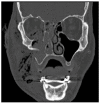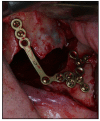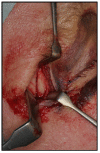Treatment of Zygomatic Complex Fractures with Surgical or Nonsurgical Intervention: A Retrospective Study
- PMID: 30202484
- PMCID: PMC6129990
- DOI: 10.2174/1874210601812010377
Treatment of Zygomatic Complex Fractures with Surgical or Nonsurgical Intervention: A Retrospective Study
Abstract
Objective: Evaluate the 1-year treatment outcome of zygomatic complex fractures with surgical or nonsurgical intervention.
Materials and methods: One hundred and forty-two consecutive patients with a zygomatic complex fracture were enrolled. Sixty-eight patients underwent surgical intervention and 74 patients nonsurgical intervention. The 1-year examination evaluated cosmetic and functional outcome including malar symmetry, ocular motility, occlusion, mouth opening, neurosensory disturbances, and complications.
Results: Forty-six patients allocated to surgical intervention responded to the 1-year follow-up examination. Satisfying facial contour and malar alignment was observed in 45 patients. All patients presented with identical position of the eye globe without enophthalmos and normal ocular movement. A habitual occlusion was seen in all patients with a mean interincisal mouth opening without pain of 49 mm. One patient presented with minor ectropion. Wound infection occurred in five patients. Persistent infraorbital neurosensory disturbance was described by 19 patients. The 1-year radiographic examination showed adequate fracture alignment in all patients with satisfying facial contour. However, dissimilar position of the orbital floor was seen in three patients having orbital reconstruction. None of the patients were re-operated or needed secondary correction of the zygomatic complex or orbital floor.
Conclusion: Surgical intervention is an effective treatment modality of depressed zygomatic complex fractures, whereas a nonsurgical approach is often used for nondisplaced fractures. Most zygomatic complex fractures can be treated solely by an intraoral approach and rigid fixation at the zygomaticomaxillary buttress. Further exposure of the zygomaticofrontal junction or inferior orbital rim is necessary for severely displaced fractures, which require additional fixation.
Keywords: Facial injuries; Maxillofacial injuries; Open fracture reduction; Surgical or nonsurgical intervention; Therapy; Zygomatic fractures.
Figures
References
-
- Ungari C., Filiaci F., Riccardi E., Rinna C., Iannetti G. Etiology and incidence of zygomatic fracture: A retrospective study related to a series of 642 patients. Eur. Rev. Med. Pharmacol. Sci. 2012;16(11):1559–1562. - PubMed
LinkOut - more resources
Full Text Sources
Other Literature Sources








